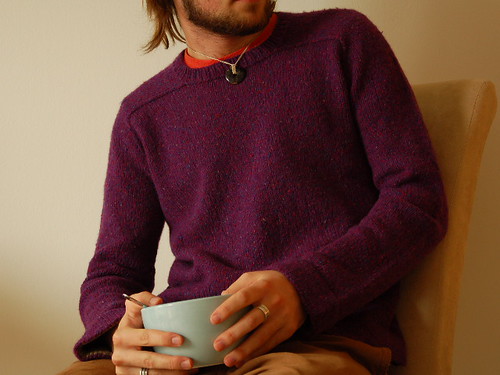
Source: Knitting Without Tears
Materials: Rowan Yorkshire Tweed DK in 'Revel' (1o Balls); Rowanspun DK in 'Rush' (less than 1 ball) for hem facings.
Needles: US 6 Clover Bamboo Circulars (29" & 16"); US 6 Crystal Palace Bamboo DPN's
Cost: $49.99 (scored a bag of Yorkshire Tweed on Ebay) + Shipping
Start Date: 26 July 2006
Completion: 18 August 2006
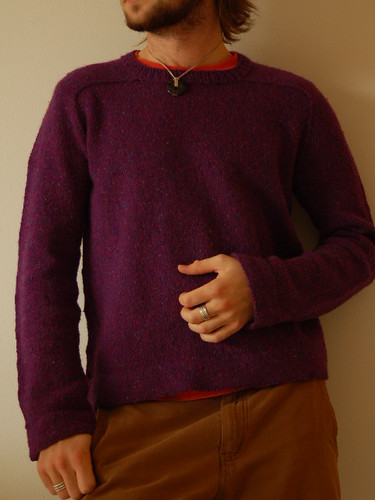
I'll do my best to explain the construction on this one. The (pure) genius lies in the simplicity. Again, I realize I'm preaching to the choir here...
Anatomy: EZ offers up 4 recipes for seamless sweaters in "Kw/oT." With the exception of yoke construction, all 4 sweaters are done in the same way. You knit the body in the round (in my case, a straight tube with no shaping), followed by two sleeves (beginning at the cuff, increasing up to the desired circumference as you approach the armhole). These three pieces are knit seperately until you've reached a preferred length. This part of the sweater was sort of a snooze-fest, but I love me some stockinette in the round, so I enjoyed it. It also goes crazily fast.
When all three pieces are completed, you join each onto one 29"+ circular needle and work one long round to join them all together (having left of 8% body circumference for the underarm on each piece) - this is the longest round you will work. From this point, you choose a yoke treatment and get to the good stuff!
The Seamless Hybrid is a tasty mixture of a standard raglan and a saddle-shoulder pullover. Work the first portion of the yoke with standard raglan decreasing, although, because we're working in the round, we can decrease at a rate of every third row (rather than every second or fourth) which gives the IDEAL raglan slope, and starts securing that wonderful fit. After a certain number of stitches have been decreased, its time to saddle up. From here on out, you will be working just the sleeve stitches back and forth, making a saddle that slowly approaces the center neck, leaving the body stitche s live on the needle. How is it seamless? As you work the saddle, you knit the last stitch of each row TOGETHER WITH ONE LIVE STITCH OF THE BODY. You are seaming up the top of the piece as you build it.(Seriously, I'm excited just explaining it). When you reach the collar - you bind of half of the stitches of the saddle and continue working them across the back. This means the neck hole is merely the front half of the sleeve saddle, in the center of the sweater. When both saddles meet in the middle, you kitchener graft them together and BAM, your sweater is all seamed up. Pop a collar on that bad boy and you're ready-to-wear.
(I realize that this description may be convolluted and confusing (much like the pattern writing!) I had to read and re-read multiple times to envision it correctly. If your having trouble, just make one, it'll all make sense to you then)
Below I have included visuals of the yoke construction (Click on them to see them in greater detail):
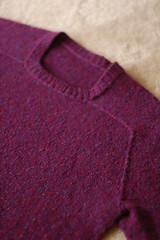
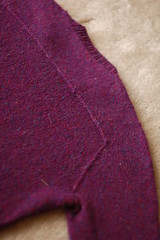
front of yoke :: back of yoke
Modifications/Personalization:
How do you make it your own? Well, first off - any sweater you make from such a general recipe will be indiviudalized based on your yarn choices: guage, drape, shaping, blah blah blah. Its the same old story. I chose to add a wide (about 2") turned hem at the sleeve and body cuffs. I liked how this added a little weight to the bottom half of the piece. It also gave me an opportunity to add a contrasting color on the hem facings.
Recognize it? Thats a little leftover Rowanspun DK from this. I like the semi-off-the-wall color combo, and the union of tweeds. (Is there any better union?)
Some of you asked about how I did this, and its a suuuuper simple process: With contrasting yarn (Rowanspun) provisionally cast-on 90% the number of stitches you plan on having at the base of your sleeve. Knit these stitches to desired cuff length (2"). Knit one round with Main Yarn (Yorkshire Tweed), increasing evenly up to 100% of cuff circumference. Purl one round (this is your turning round). Now begin to knit normally with your Main Yarn. When you have knit the equal length with your Main Yarn that you had previously done with your Contrasting Yarn (2"), it is time to join them together: Fold the hem and begin your round, knitting two stitches together on every stitch (one contrasting yarn stitch, and one main yarn stitch). Keeping with the whole "seamless" theme, we are bypassing the insanely annoying step of sewing down hem facings (cringe). *NOTE: you are knitting together 10% more Main Yarn stitches than Contrast Yarn Stitches... you will need to calculate for this and skip a K2tog every once in a while (you'll only knit the Main Color by itself).
EZ suggested finishing with a hemmed collar as well - which was my original plan. However, when I did this it looked rotten. It really didn't fit. So I went with a 1x1 ribbed collar and a tubular (kitchener) bind off (i love how clean that one is). I like the finished product
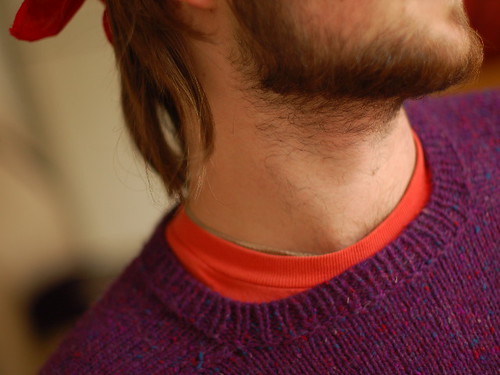
So... now that I've written a short thesis, I'll conclude. I hope this was in some way informative and not too confusing. My main goal here is to spread ideas and inspiratin about sweater construction. Thats what keeps me coming back to all this you know.
And for the record, this is my best fitting garment yet - I really like how it feels, and post blocking, my wool-too-scratchy worries were soothed, its definitely wearable! I've been sportin it around in this rainy Chicago weather for 3 days already
and its back to knitting.
And for the record, this is my best fitting garment yet - I really like how it feels, and post blocking, my wool-too-scratchy worries were soothed, its definitely wearable! I've been sportin it around in this rainy Chicago weather for 3 days already
and its back to knitting.
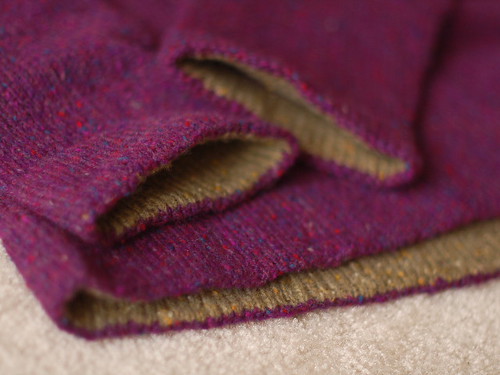
0 comments:
Post a Comment